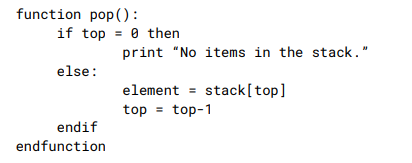Determining the preconditions for devising a solution to a problem
1/8
There's no tags or description
Looks like no tags are added yet.
Name | Mastery | Learn | Test | Matching | Spaced |
|---|
No study sessions yet.
9 Terms
What are preconditions in programming?
Preconditions are requirements that must be met before a program can be executed. If the preconditions are not met, the program will fail to execute or return an invalid answer.
What is the purpose of specifying preconditions for a subroutine?
Specifying preconditions ensures that a subroutine can safely expect the arguments passed to it to meet certain criteria, preventing errors during execution.
How can preconditions be tested in a program?
Preconditions can be tested within the code, but they are often included in the documentation accompanying a subroutine, library, or program.
What happens in the pop() function if the stack is empty?
If the stack is empty, the pop() function checks whether the top pointer is 0 and prints “No items in the stack.” If this condition is not checked, attempting to pop from an empty stack could cause an error and crash the program.

What role do preconditions play in the pop() function?
The precondition checks whether the stack is not empty (i.e., top > 0), preventing an error when attempting to pop from an empty stack.
How are preconditions typically handled in function documentation?
Preconditions are often specified in the documentation, where it is the user’s responsibility to ensure that inputs meet the specified requirements.
What is an example of a precondition documented for a function?
A common example is the factorial function, which can only be called upon positive numbers. This precondition is specified in the documentation, rather than being checked within the code.
How do preconditions benefit program development?
Including preconditions within documentation reduces the length and complexity of the program and saves time needed to debug and maintain the program.
Why are preconditions important for the reusability of subroutines?
Preconditions ensure that necessary checks are carried out before execution, either by the user or as part of the subroutine, making the subroutine more reusable and less error-prone.